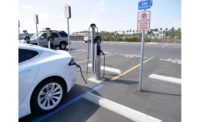The Energy Future
Microgrids: Ten Minutes With Veolia's Jack Griffin
A discussion about who needs a microgrid and the role of architects and engineers

A microgrid in Puerto Rico installed by Louis Berger for the U.S. Army Corps of Engineers. Photo by Pamela Radtke Russell for ENR
Jack Griffin, a vice president at one of Veolia North America’s energy services units, has more than 25 years of experience in the energy industry with a current focus on distributed generation, including combined heat and power and microgrids. Griffin is an engineer and expert in energy systems development and application. He recently spoke with ENR's Pamela Radtke Russell about the role of microgrids in an age of climate change, who should use a microgrid and the role or architects and engineers.
ENR What is the current state of the microgrid industry?

There’s a lot of excitement in the microgrid sector right now. I’m seeing a real momentum change over the last 18 months. I think the realization of the hurricanes from the previous year raised awareness of microgrids. There are more mainstream organizations looking at how to control their own energy destiny. In particular states in the middle of America, like Illinois, are getting involved, which tells me that microgrids are gaining momentum and credence.
What is driving the growth of microgrids?
Hurricanes gave the country an awareness of the fragility of the energy delivery system. There is also a growing acceptance that we must deal with global warming and one effective way to do so is to use renewable energy sources in close proximity of energy loads, using the microgrid as the infrastructure backbone.
What is the one thing about microgrids that you wish more people were aware of?
The regulatory framework and effort to get a project built takes time. It’s not something you can decide you want to tomorrow and have it built by the next day. Also, it’s important to know that microgrids and distributed generation combined allow you to increase your penetration of renewables. Finally, microgrids are achievable. They are not new technologies, they are building blocks and application of existing technologies.
Who should be considering incorporating microgrids in their buildings and facilities?
The answer is going to change over time. I think the organization that gets the highest value from a microgrid today is an entity that needs to have continuity of energy supply. Mission-critical facilities, hospitals, data centers, public safety organizations all need the ability to withstand and respond to a weather event or an externality event. Secondly, the general public, like large residential complexes that want the ability to have refuge in place but also want the ability to utilize renewable resources in their area
What roll do engineers and architects play in designing and planning microgrids?
First and foremost they need listen carefully to what the owners’ needs are. What is the objective? Is it just to respond to externalities, or is it to integrate renewable resources? Also, they should understand the depth and breadth of what technologies are available as well as the regulatory environment and explain those both to your owners.
What should planners and architects keep in mind when planning to incorporate microgrids?
Scope, what does that include? How many buildings, what kind of assets, what are the primary uses, secondary uses? They should understand the interconnection points: From a physicality perspective they need to interface with the electric grid; from a government and regulatory perspective, what permits and permissions will be needed? Also, who is going to operate the system and how it is going to be operated? How do you know that 30 years from now what you designed is going to continue to serve the needs?
What are the circumstances that make installing microgrids most cost-effective and worthwhile for the owner?
The differential between raw fuel and finished product of electricity is a major component that makes microgrids and combined heat and power systems worthwhile. Also, the cost of interruption. I have clients specifically tell me there is a lost opportunity cost if they have an interruption of power supply. That places value on the redundancy and capability of a microgrid so they don’t have interruption of production.
What do you expect the next year to bring for the microgrid industry? What do you foresee for the next five years?
I think in the next year you will see the results of test cases that are being installed now. What you’ll see in the next year are lessons learned and adjustments to approach and scope. In five years from now, microgrids are going to be a key element to the decarbonization for the country. I think the ability to have a bunch of small networks interconnecting and working like a mesh and enabling lower carbon resources, and being able to use those lower-enthalpy thermal resources in conjunction with electrification is going to be a big piece of our energy future. The ability to draw more electricity off a higher penetration of solar, wind, and geothermal resources, combined with the electrification of the transportations system — that’s where we will be five year from now.






